Contact Us
Contact Us

Millions of people worldwide suffer with incontinence, or the inability to regulate bladder or bowel movements, which has a substantial impact on their quality of life. While incontinence can occur at any age, it is more common in older adults and women, particularly those who have given birth. The illness can range from a minor leak of urine while coughing or sneezing to full inability to control urinary or fecal output. Understanding the many types, causes, and treatment options for incontinence is critical for successful management and improving the lives of individuals affected.
Urinary incontinence is classified into numerous categories, each with its own unique set of characteristics. Stress incontinence occurs when physical exertion, such as coughing, sneezing, or exercising, increases pressure on the bladder, resulting in leakage. Urge incontinence, also known as overactive bladder, is characterized by a sudden and urgent urge to urinate, followed by an involuntary loss of urine. Mixed incontinence is the combination of stress and urge incontinence. Overflow incontinence occurs when the bladder does not fully empty, resulting in frequent or continuous dribbling of pee. Functional incontinence is defined as physical or mental problems that prohibit a person from using the restroom on time.
Incontinence can be caused by a variety of factors, including pregnancy and childbirth, which weaken the pelvic floor muscles, as well as hormonal changes during menopause. Obesity, which raises abdominal pressure, as well as certain medical diseases like diabetes, multiple sclerosis, and Parkinson’s disease, are other contributors. Medications, urinary tract infections, and constipation can all aggravate incontinence. Men with prostate disorders, such as benign prostatic hyperplasia or prostate surgery, may experience urine incontinence.
The kind and severity of incontinence, as well as the underlying reason, determine the appropriate treatment. Weight loss, dietary changes, and pelvic floor exercises (Kegel exercises) can all help alleviate discomfort. Bladder training approaches, such as scheduling toilet trips and delaying peeing, can help with urge incontinence. Medications may be prescribed to relax or improve bladder capacity. In more severe cases, surgical interventions, such as sling procedures or bladder neck suspension, may be required to support the bladder or urethra. Dietary adjustments, bowel training, and, in some cases, surgery can all help persons suffering with bowel incontinence.
In addition to medical therapies, there are a variety of items available to help manage incontinence and improve quality of life. Absorbent pads, adult diapers, and urine catheters can offer unobtrusive and effective incontinence solutions. Seeking advice from healthcare professionals, such as urologists or continence specialists, can also help you develop a specific management strategy.
Post a Comment